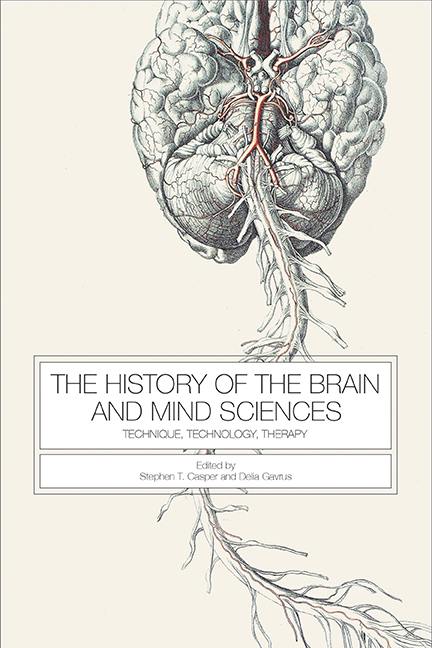Book contents
- Frontmatter
- Contents
- Acknowledgments
- Introduction
- 1 “We Are Veritable Animals”: The Nineteenth-Century Paris Menagerie as a Site for the Science of Intelligence
- 2 “Physiological Surgery”: Laboratory Science as the Epistemic Basis of Modern Surgery (and Neurosurgery)
- 3 Configuring Epidemic Encephalitis as a National and International Neurological Concern
- 4 Circuits, Algae, and Whipped Cream: The Biophysics of Nerve, ca. 1930
- 5 Epilepsy and the Laboratory Technician: Technique in Histology and Fiction
- 6 “What Was in Their Luggage?”: German Refugee Neuroscientists, Migrating Technologies, and the Emergence of Interdisciplinary Research Networks in North America, 1933 to 1963
- 7 Dualist Techniques for Materialist Imaginaries: Matter and Mind in the 1951 Festival of Britain
- 8 A “Model Schizophrenia”: Amphetamine Psychosis and the Transformation of American Psychiatry
- 9 Salvation through Reductionism: The National Institute of Mental Health and the Return to Biological Psychiatry
- Coda: Technique, Marginality, and History
- Bibliography
- List of Contributors
- Index
7 - Dualist Techniques for Materialist Imaginaries: Matter and Mind in the 1951 Festival of Britain
Published online by Cambridge University Press: 26 May 2021
- Frontmatter
- Contents
- Acknowledgments
- Introduction
- 1 “We Are Veritable Animals”: The Nineteenth-Century Paris Menagerie as a Site for the Science of Intelligence
- 2 “Physiological Surgery”: Laboratory Science as the Epistemic Basis of Modern Surgery (and Neurosurgery)
- 3 Configuring Epidemic Encephalitis as a National and International Neurological Concern
- 4 Circuits, Algae, and Whipped Cream: The Biophysics of Nerve, ca. 1930
- 5 Epilepsy and the Laboratory Technician: Technique in Histology and Fiction
- 6 “What Was in Their Luggage?”: German Refugee Neuroscientists, Migrating Technologies, and the Emergence of Interdisciplinary Research Networks in North America, 1933 to 1963
- 7 Dualist Techniques for Materialist Imaginaries: Matter and Mind in the 1951 Festival of Britain
- 8 A “Model Schizophrenia”: Amphetamine Psychosis and the Transformation of American Psychiatry
- 9 Salvation through Reductionism: The National Institute of Mental Health and the Return to Biological Psychiatry
- Coda: Technique, Marginality, and History
- Bibliography
- List of Contributors
- Index
Summary
For the past three centuries, the aim of biological studies and of medicine has been the understanding of the physiology and pathology of the body proper. The mind was out, largely left as a concern for religion and philosophy, and even after it became the focus of a specific discipline, psychology, it did not begin to gain entry into biology and medicine until recently.
—Antonio Damasio, 1994Introduction
We can say that the power to learn to refrain from attacking lies in this uppermost part of the brain. This power is clearly very like the memory of higher animals or man. The interest of the experiment is that it opens some hope for finding what changes go on in the brain when animals learn. We now know where to look in the Octopus brain and we hope that by comparing this part with those regions of our own brain that are connected with learning, we may be able to find the common fact that makes memory possible.
Thus wrote physiologist J. Z. Young in a script solicited by the Committee for Science and Technology for the 1951 Festival of Britain and for which Young proposed a novel exhibit focused on memory in the octopus. Describing the natural history and behavior of this marine animal, Young explained to his readers those reasons that rendered the invertebrate a model organism for the science of physiology. Noting that octopuses proved to be particularly clever creatures, Young claimed they were highly amenable to training. “The experiment consisted,” he wrote, “in training the Octopus not to attack a crab if a white square was also present” in their aquarium. When the square was not present the octopus could feed on the crab. By presenting the crab and the white square together to the octopus, the animal could be trained to associate the white square and the crab with painful experiences. “This was done by dangling the crab on a thread in front of the square to which a pair of electric wires were attached. When the Octopus came out and attacked the crab, it received an electric shock, dropped the crab and retreated home.”
- Type
- Chapter
- Information
- The History of the Brain and Mind SciencesTechnique, Technology, Therapy, pp. 183 - 201Publisher: Boydell & BrewerPrint publication year: 2017

